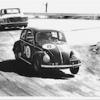If I wished to build a perfect replica of a racing car (name your preferred era) using authentic materials and using period manufacturing techniques, how close could I get?
This is a thought experiment; I'm not trying to fake a racing car. I'm assuming hypothetically that I could source an original engine, gearbox and other proprietary forged or cast components. I'm thinking about the difficulty of sourcing correct gauge and composition steel and aluminium alloy (sheet, bar, tube). Thinking a bit harder, I'll add less obvious materials such as brass, rubber and chopped strand mat. Wiring loom? Plus I'd need to have access to period metal forming equipment, welding kit and plating apparatus.
We have all seen fabulous recreations and restorations of old cars. They are glorious and we tolerate 'fakery' (modern materials in fuel and electrical lines) for good reason.
A 1950s racing body was made from Duralumin, a trade name so we can assume that most bodies were made from something else which was like Duralumin. Could I buy the 'real thing' today?



















